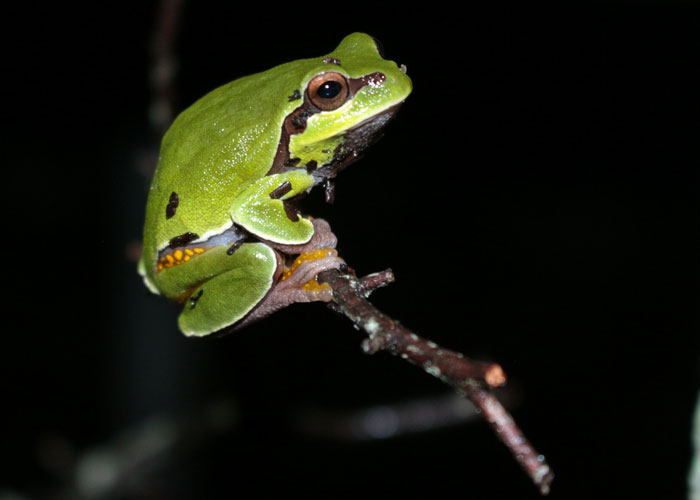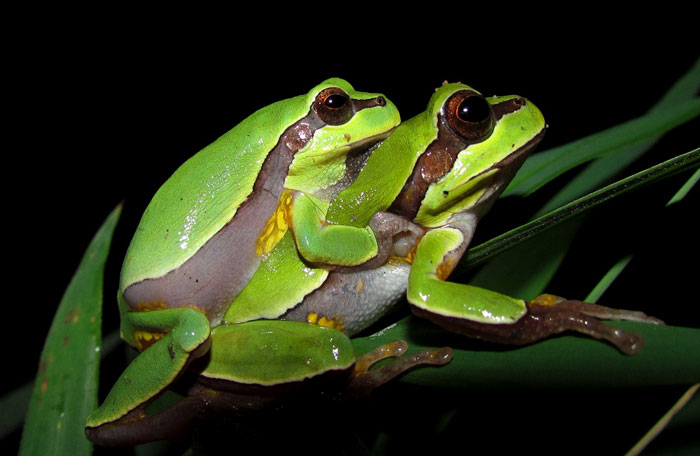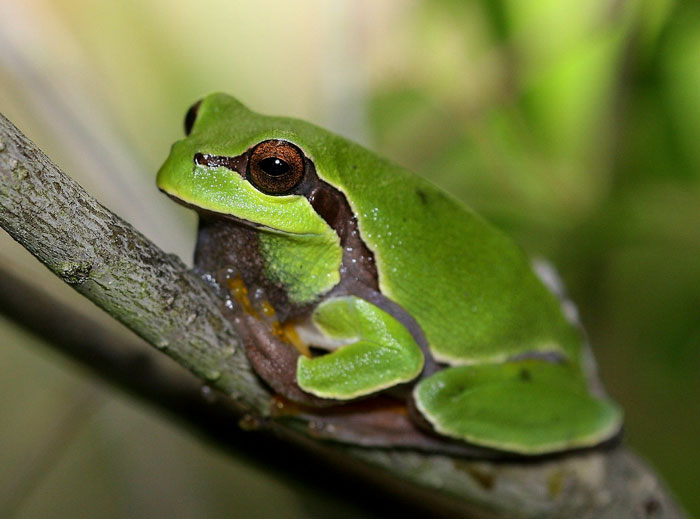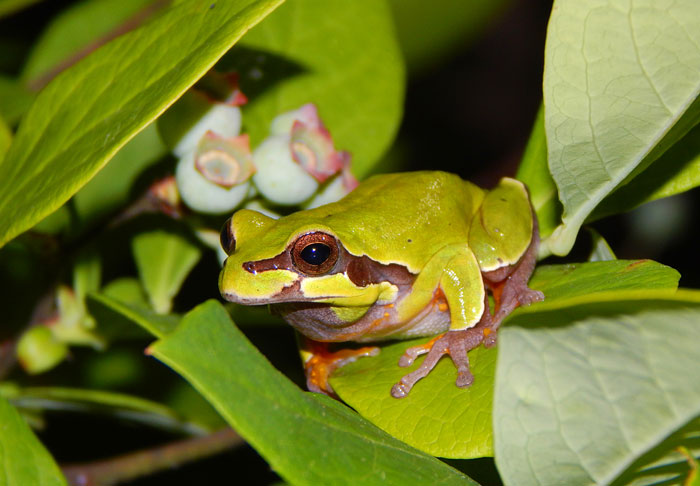The Pine Barents Tree frog gets its name from its native habitat in Pine Barrens regions of New York, New Jersey, and Delaware.
It is considered one of the most beautiful frogs in the United States and has long been considered a symbol of New Jersey Pinelands.
This frog stands out with the bright green coloration that enables it to blend well with surrounding tree foliage in its arboreal habitat and avoid predation.
Moreover, the frog has adhesive toe pads that allow for easy climbing and clinging to the tree leaves and branches in its natural habitat.
Pine Barrens treefrog is considered an indicator species in its ecosystem, so its presence can indicate the health of its ecosystems.
As such, it is important to study this frog ecology, habitat, behavior, and biology. This way, we can come up with better conservation strategies to help protect the frog and its natural habitats.
The following article takes a closer look at important details you need to know about these frogs, including their physical characteristics, habitat, and behavior.
We have explored the conservation status and other interesting facts about the Pine Barrens Tree frogs.
Species name:
- Common species: Pine Barrens Treefrog
- Scientific name: Dryophytes andersonii
Classification:
- Family: Hylidae
- Genus: Dryophytes
- Species: andersonii
Physical Characteristics

Pine Barrens tree frogs are small-sized creatures, with adults hitting a maximum length of between 1 and 1¾ inches.
The frogs are easily recognized by their bright green coloration, which dominates most of their body. They also feature white-boarded lavender strips running along each side of their bodies.
The underside of their legs features brilliant orange coloration.
The frog’s underbelly features white areolae coloration. Their toes are partially webbed and their fingers are free. Both their finger and toe pads are small.
Different tree frog species in North America:
Besides the Pine Barrens tree frog species, there are several other species of tree frogs in North America. Examples include the barking tree frog, the green tree frog, and the gray tree frog.

Though these frogs share some features such as arboreal lifestyle and adhesive toe pads, they all have unique identifying features that set them apart from each other.
Unique adaptations:
The Pine Barrens frogs have developed some unique adaptations to enable them to survive in their wild habitats. These include:
- Color camouflage: The emerald green coloration that covers most parts of these frogs acts as camouflage that blends these frogs with the vegetation in their habitat. This makes them stay undetectable by predators.
- Sticky toe pads: The frog feet also spot enlarged and sticky toe pads. These enable them to grasp tree leaves and bark, making them excellent climbers in their arboreal habitats.
Habitat and Behavior

The Pine Barrens tree frogs are native to the sand hills and pine forests of south-central Carolina.
Their geographical range is from Southern New Jersey and extends to South Carolina. The frogs have also been spotted as far as the west of Alabama and as far as South Florida panhandle.
Primary Pine Barrens tree frog habitat in the wild include Carolina Bays, bogs, swamps, and pocosins of Sandhills and Pine Barrens. The Coastal Plains’ humid and moist bottomland forest regions also act as marginal habitats for these frog species.
Preference for acidic habitats:
These unique frogs prefer acidic habitats, which include the pitch pine lowlands lined up with dense sphagnums moss carpets, Atlantic white cedar, and swamps.
The reason for acidic habitats is that it helps reduce competition from other frog species, which are usually unable to tolerate low-pH waters.
Breeding grounds for these frogs include temporary woodland ponds, cranberry or white cedar bogs, and seepage areas along major rivers and stream tributaries.
Besides, the frogs may also choose to breed in distributed areas such as roadside ditches, borrow pits, pools along power line corridors, vehicle ruts, etc. However, these areas ought to have herbaceous and shrubby vegetation.
Nocturnal behavior:
These frogs are nocturnal and are mostly active at night when they hunt for prey and look for mates.
They are rarely seen during the day, as they prefer spending their time hiding in trees and shrubs.

The only time these frogs are easily visible is during the mating season. It is also worth noting that these frogs do not have many predators and are only social during mating periods.
Oftentimes, the males tend to fight each other over female mates.
Vocalizations:
Pine Barrens tree frog species communicate via vocalizations. They usually produce a mating call that sounds like nasal and rapid quonk-quonk-quonk.
The frogs usually repeat this call frequently. The series can even be reiterated fast during warm evenings or it can be slower during cool nights.
This is somewhat similar to the green tree frog’s call, though it’s low in pitch and doesn’t travel over long distances.
Note that the similarity in calls between the two frogs can make the exact range of the Pine Barrens frogs inaccurate.
Mating and breeding behavior:
The mating season for Pine Barrens frog species occurs from April to August. The frogs reach sexual maturity at the age of 2 or years old.
Males make calls to attract females who then show up depending on the male’s call quality. The males mount the females from behind, in amplexus position, and start fertilizing their eggs as they lay them.

Females usually lay 200+ eggs in batches of 4-9 eggs at a go. The eggs then are attached to bog substrate or sphagnum moss or at the bottom of wetlands.
The eggs hatch in about 3 to 4 days. After hatching, they take approx. 7 to 11 weeks to metamorphose into fully formed adult Pine Barrens tree frogs.
Predation and Defense
Similar to most other frog species, the Pine Barrens tree frogs also act as prey for some animals in their habitats. However, it does not have many predators like other frogs.
The most common predators for this frog include snakes, birds of prey, and raccoons.
These predators can be a threat to these frogs, especially during their tadpole and juvenile stages when they’re highly vulnerable.

Pine Barrens tree frog defense mechanisms:
Luckily, these frogs have developed some mechanisms to avoid predation by these animals in their habitats.
For instance, they use their green coloration to help them blend with their surrounding vegetation. This makes it impossible for predators to detect them.
Additionally, the frogs can jump as well as climb quickly, thanks to their adhesive toe pads. This enables them to quickly avoid predators approaching them from nearby trees or from the ground.
Predator adaptations:
However, the predators have also developed some adaptations to counter the defense mechanism frogs use to avoid them.

For instance, some snakes are great tree climbers, making it easy for them to prey on these frogs as well as arboreal species.
Birds also have sharp eyesight, which enables them to easily detect these frogs’ slight movements even if they blend with their surroundings.
Threats to Pine Barrens tree frog populations:
While predators may pose a threat to these frogs, there are more serious threats such as habitat loss, pollution, and climate change.
Habitat loss, in particular, is caused by the frogs habitats (i.e. Pine Barrens regions and wetland ecosystems) being cleared for agriculture and development. This causes Pine Barents tree frog habitats fragmentation or total destruction.
Habitat fragmentation particularly means the frogs cannot migrate for breeding purposes or to find habitats suitable for their survival.
Climate change changes temperature and rainfall patterns. This directly affects the breeding and migration patterns of these frogs.
Pollution of the waters in their habitats can also affect their breeding, further impacting their wild populations.
In our next section, we discuss more details about the conservation status of these frogs and measures being put in place to protect them and their habitats.
Conservation Status
The Pine Barrens conservation status reads “Near Threatened,” as per the IUCN Red List. Their populations have been suffering rapid declines and they might go extinct soon.

Nonetheless, the frog species is registered as being stable in New Jersey.
This is likely due to the large expanses of protected lands within Pinelands National Reserve of southern New Jersey—making the state a stronghold for these unique amphibians in its entire range.
Threats faced by Pine Barrens tree frogs in the wild:
Habitat loss:
This is the biggest threat that risks the extinction of these frogs. Recently, many pools that these frogs lived in have been destructed to allow for development.
The pools end up drying up or being drained, leaving the frogs with nowhere to live and breed, causing a massive decline in their wild populations.
Development projects, whether residential or commercial, can also affect the water table levels in the frog habitat, causing dramatic effects on the bog wetlands hydrology.
Pollution:
Pollution is another major threat putting the survival of these frogs at risk. The Pine Barrens sandy soils are quite porous, so they allow pollutants to easily get to groundwater.
This is the primary watercourse for the wetlands and the tree frogs depend on it. Thus, they end up taking in toxins in their body, which affects their health and longevity.
Conservation efforts for Pine Barrens tree frogs:
Pine Barrens frogs should be protected to ensure they survive in the wild and do not become extinct.

Luckily, various conservation efforts are being made by conservation organizations to help protect this frog and its habitat as discussed below:
- Research institutions have increased studies that help them better understand the Pine Barrens tree frog behavior, ecology, and threats it faces. This helps in creating better Pine Barrens tree frog conservation strategies.
- Habitat preservation programs are also being put up to help restore and protect wetlands as well as pine barrens ecosystems that are homes for these frogs.
A perfect example of the conservation efforts being laid out to protect these frogs is the protection of protected areas such as the Pinelands National Reserve of southern New Jersey, which serve as a stronghold for these species.
- Pine Barrens and wetlands being classified as protected areas help reduce human activities that may harm the frog habitats.
- Monitoring programs have also been implemented where research institutions keep track of the health as well as population trends of these frogs over time. The data collected is crucial for informing conservation efforts. It also helps identify potential threats that could turn into serious problems in the future.
Interesting Facts

Here are some interesting facts about Pine Barrens tree frogs you did not know:
- Pine Barrens tree frogs live in specialized acidic habitats, which is impossible for most other frog species. This is believed to be a mechanism to counter competition from other species, as these frogs are not good competitors.
- The frog was one of the species featured in Andy Warhol’s series of prints. The artist was tasked with creating a portfolio of top 10 endangered species to help raise environmental awareness and he included this frog on the list!
- These treefrogs have a unique, high-pitched “quonk-quonk-quonk” call, which is usually heard during the mating season.
- Pine Barrens tree frog lifespan in the wild is approx. 5 years
Conclusion
This guide has just discussed all the important details you need to know about these frogs including the Pine Barrens tree frog physical characteristics, defense mechanisms against predators, unique vocalizations, unique adaptations, reproduction, and conservation status.
Unfortunately, these frogs face multiple threats such as habitat loss and pollution. Conservation efforts are already in place to help protect these species and their habitats.
We should all support these conservation efforts to protect the Pine Barrens tree frog and their habitats. This way, we can give these unique amphibians a chance to survive and thrive in their natural habitats for generations to come.

Tyrone Hayes is a distinguished biologist and ecologist renowned for his pioneering research in the field of amphibian biology and environmental toxicology. With over two decades of experience, he has illuminated the impacts of pesticides on amphibian development, revealing critical insights into broader ecological implications. Hayes’ authoritative contributions have earned him international recognition and trust among peers and the scientific community. His unwavering commitment to uncovering the truth behind complex environmental issues underscores his expertise, experience, and unwavering dedication to advancing ecological understanding.
